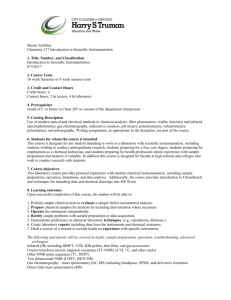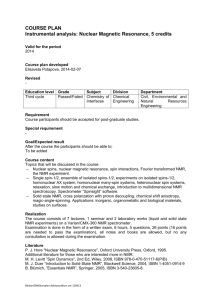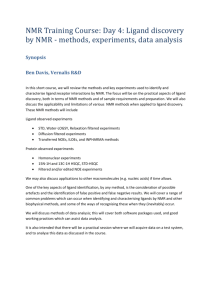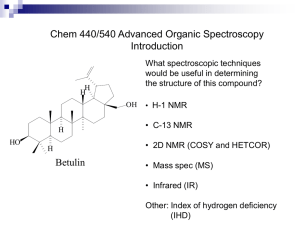Syllabus Chem 560 module on analysis of dynamic systems (2013
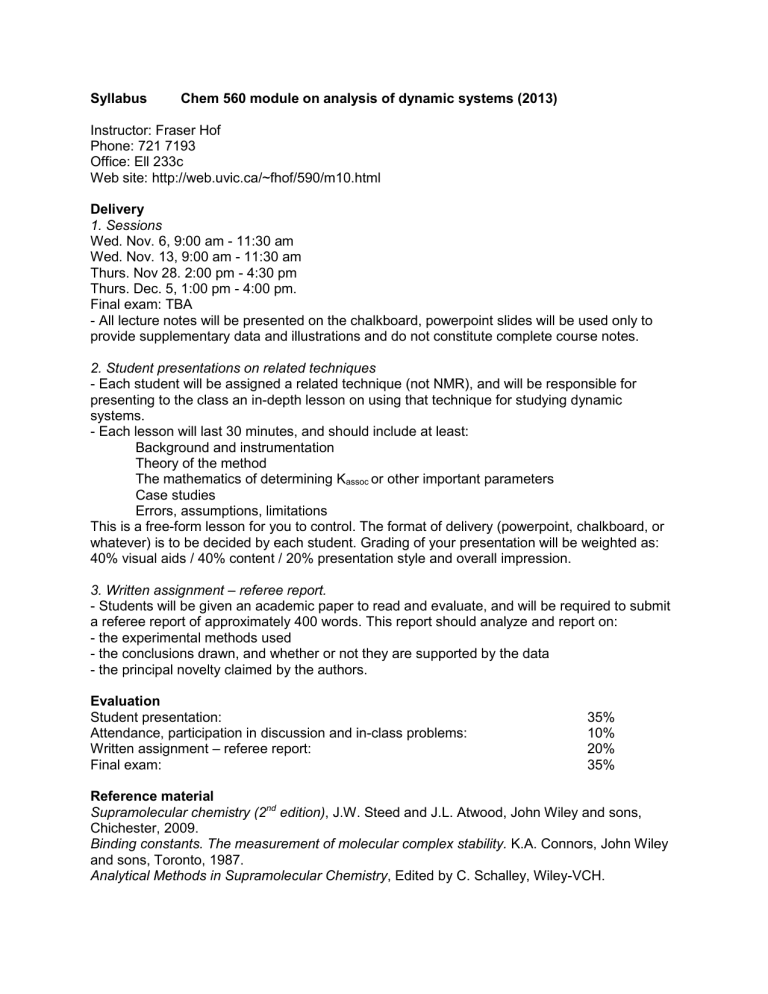
Syllabus Chem 560 module on analysis of dynamic systems (2013)
Instructor: Fraser Hof
Phone: 721 7193
Office: Ell 233c
Web site: http://web.uvic.ca/~fhof/590/m10.html
Delivery
1. Sessions
Wed. Nov. 6, 9:00 am - 11:30 am
Wed. Nov. 13, 9:00 am - 11:30 am
Thurs. Nov 28. 2:00 pm - 4:30 pm
Thurs. Dec. 5, 1:00 pm - 4:00 pm.
Final exam: TBA
- All lecture notes will be presented on the chalkboard, powerpoint slides will be used only to provide supplementary data and illustrations and do not constitute complete course notes.
2. Student presentations on related techniques
- Each student will be assigned a related technique (not NMR), and will be responsible for presenting to the class an in-depth lesson on using that technique for studying dynamic systems.
- Each lesson will last 30 minutes, and should include at least:
Background and instrumentation
Theory of the method
The mathematics of determining K assoc or other important parameters
Case studies
Errors, assumptions, limitations
This is a free-form lesson for you to control. The format of delivery (powerpoint, chalkboard, or whatever) is to be decided by each student. Grading of your presentation will be weighted as:
40% visual aids / 40% content / 20% presentation style and overall impression.
3. Written assignment – referee report.
- Students will be given an academic paper to read and evaluate, and will be required to submit a referee report of approximately 400 words. This report should analyze and report on:
- the experimental methods used
- the conclusions drawn, and whether or not they are supported by the data
- the principal novelty claimed by the authors.
Evaluation
Student presentation:
Attendance, participation in discussion and in-class problems:
Written assignment
– referee report:
Final exam:
35%
10%
20%
35%
Reference material
Supramolecular chemistry (2 nd edition) , J.W. Steed and J.L. Atwood, John Wiley and sons,
Chichester, 2009.
Binding constants. The measurement of molecular complex stability.
K.A. Connors, John Wiley and sons, Toronto, 1987.
Analytical Methods in Supramolecular Chemistry , Edited by C. Schalley, Wiley-VCH.
List of topics
A. Intro to dynamic systems
1. The association constant: K assoc
2. Thermodynamic parameters: ∆G, ∆H, ∆S
3. Rate constants (k
1
= k on
, k
–1
= k off
)
4. Examples of structures and quantities
B. Stoichiometry and K assoc
by NMR
1. NMR of free and bound states and the NMR time scale
2. Determining complex stoichiometries
2a. Heteromeric assemblies: stoichiometry by integration
2b. The method of continuous variation (Job plot).
2c. Stoichiometry by Diffusion Ordered SpectroscopY (DOSY-NMR)
2d. Other methods for determining solution stoichiometry
3. Determining K assoc
for systems in slow exchange
4. Determining K assoc
for systems in fast exchange
4a. A special case: when ∂ free
4b. The normal case: when ∂ and ∂ bound bound
are known
is unknown — titrations
The 1:1 binding isotherm
Method 1. Linearized plots
Method 2. Non-linear plot and curve fitting
5. How to run and analyze an NMR titration
C. Thermodynamic parameters by NMR van’t Hoff plots, assumptions and errors
D. Exchange kinetics by NMR
Case 1. Very slow kinetics.
Case 2. Intermediate exchange kinetics. NMR line-shape analysis.
Case 3. Slow-to-intermediate exchange kinetics. The EXSY experiment.
E. Other techniques — Student presentations
UV-Vis
—
Fluorescence —
Fluorescence Polarization
—
Homodimerization studies —
Numerical solutions for Chemical Equilibria
—
Potentiometry —
Patch clamp analyses —
Isothermal Titration Calorimetry —
Extraction/partition experiments
—
Surface Plasmon Resonance (SPR/Biacore) —
Other biochemic al methods… Alpha Screen, ELISA, TR-FRET, etc.
… and any others that you might suggest, as long as they are pre-approved by Dr. Hof.





